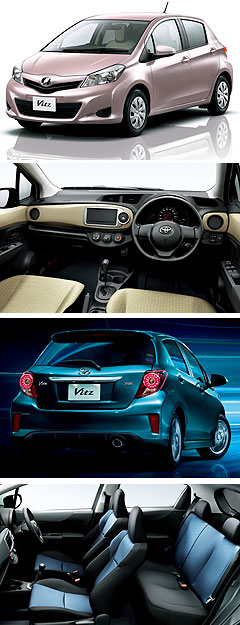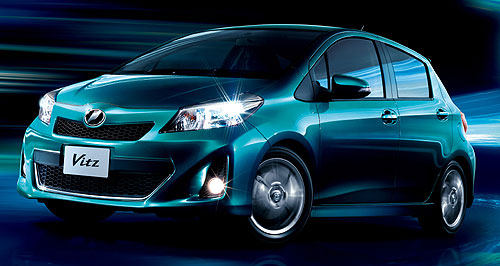Make / Model Search
Future models - Toyota - YarisFirst look: Toyota yields new YarisOn sale elsewhere: Full pricing, details and images of Toyota’s redesigned Yaris have been announced in Japan. Next Yaris launched in Japan but Aussies must wait longer for new Toyota baby23 Dec 2010 TOYOTA has launched its third-generation Yaris in Japan three days before Christmas, but the bigger, edgier and more fuel efficient successor for one of Australia’s top-selling models remains the best part of a year away from local showrooms. Now on sale in its home market, where the Yaris is known as the Vitz (which phonetically means ‘joke’ in Hungarian), Toyota’s all-new light-car emerges with the more angular look already previewed by a leaked dealer brochure in October. Like the model it will replace here by September 2011 – after going on sale in mainland Europe mid-year - the MkIII Yaris hatch is a full 135mm longer than the current model (3885 versus 3750mm), with a 50mm-longer wheelbase liberating 35mm of extra cabin length (now 1915mm) cabin and 35mm more rear legroom. Despite that, Toyota says the new Yaris – which is the same width as before (1695mm) but about 20mm lower at 1500mm – offers a slightly tighter turning circle of 9.0 metres, improved aerodynamic efficiency of 0.285Cd (down from 0.30) and is about 30kg lighter at 1000kg in base trim. As Toyota announced earlier this month, the fitment of its ‘Smart Stop’ idle-stop system in a 1.3-litre four-cylinder petrol model with front-wheel drive in Japan (where all-wheel models are also available) will reduce fuel consumption to a headline-grabbing 21.8 kilometres per litre (4.59 litres per 100km) and CO2 emissions to 106 grams per kilometre, according to that nation’s latest JC08 test cycle. Toyota says that will make the new Yaris the most fuel-efficient new vehicle in Japan, excluding mini (Kei) cars and hybrid models like the Prius. Australia’s new Yaris line-up is yet to be confirmed, but the current Yaris 1.3 hatch manual returns 141g/km and 6.0L/100km (6.5L/100km auto), while 1.5-litre five-door models return 6.1L/100km (6.7L/100km auto). Toyota Australia offers the existing Yaris hatch, which went on sale here in November 2005, in 1.3-litre YR and 1.5-litre YRS (and YRX five-door) guises, while the Yaris sedan (launched here in March 2006) comes in 1.5-litre YRS and YRX form. In Japan, where an entry-level 1.0-litre version is also available, all Yaris 1.3s will be powered by Toyota’s 1NR-FE engine with dual variable valve timing (instead of the current model’s VVT-i system), matched with either a five-speed manual gearbox or a continuously variable, dubbed Super CVT-i. T  oyota’s home market will have access to four specification grades, 17 exterior paint colours (up from 10) and four colour schemes (black/brown, black/blue, black/white and black/beige) for the more sophisticated new Yaris interior, which features a large padded highlight trim that extends horizontally from the instrument panel to the doors. oyota’s home market will have access to four specification grades, 17 exterior paint colours (up from 10) and four colour schemes (black/brown, black/blue, black/white and black/beige) for the more sophisticated new Yaris interior, which features a large padded highlight trim that extends horizontally from the instrument panel to the doors.The ‘F’ grade opens the Japanese range, while the ‘U’ grade adds heated seats and leather highlights, the new ‘Jewela’ grade offers silver highlights and exclusive body and cabin colours, and the RS sports flagship comes with a more aggressive front bumper, rear roof spoiler, 16-inch alloy wheels, foglights, sports seats, a leather-clad steering wheel and a Sports Sequential Shiftmatic CVT auto with seven selectable speeds. No efficiency figures have been announced for the 1.0 and 1.5-litre variants and it is unknown whether 1.3-litre models will be available with idle-stop in Australia. Similarly, the first diesel and hybrid versions of the Yaris are expected to appear in overseas markets in 2012, but their local future is uncertain. Inside, Toyota says all models come with new front seat frames to improve comfort, a 60/40-split folding rear seat, 60mm of driver’s seat height adjustment (up 15mm), 10mm of extra front seat slide adjustment, a 145mm-deeper cargo floor with a new two-height deck board, a plastic barrier to confine cargo on the front passenger seat, a single windscreen wiper, automatic headlights and UV-reducing front door glass, which Toyota says is the first in the world to reduce 99 per cent of ultraviolet light – the same level of UV protection as wearing gloves. All Japanese-spec models will come with twin front airbags (with the option of front-side and curtain airbags), electronic traction/stability control, ABS brakes and electronic brake-force distribution (EBD), while customers can pay extra for a hard-drive navigation system steering wheel controls and a colour rear-view monitor for reverse parking. Designed to attract a higher number of male customers than its more effeminate looking forebear, the new Yaris is now in production at Toyota’s Nagakusa plant in Japan, where it is expected to attract 10,000 domestic sales per month. Australia’s current Yaris is sourced from Japan and Toyota Australia has confirmed it is investigating imports from lower-cost production sources such as Thailand, which already produces the existing Yaris. If sourced from Thailand, which has a free trade agreement with Australia, the Yaris would join a procession of new light-car models to come from our nearer northern neighbour in recent times, including the facelifted Mazda2 and Ford Fiesta, Nissan’s all-new Micra and Honda’s Jazz. Next month’s facelifted Jazz will be the first in a gaggle of new light-car entrants due in 2011, including Suzuki’s MkIII Swift (February), Hyundai’s i25/Accent sedan, all-new Chinese mini-cars from Geely and Chery around March, Great Wall’s first passenger car (September) and Holden’s redesigned Barina in October. The same month will see Proton upgrade one of Australia’s most inexpensive models, the S16 sedan, and also expected on sale here later next year are Nissan’s new Micra-based sedan, an upgraded Mazda2, Skoda’s Fabia and, perhaps, the Opel Corsa and Hyundai’s sub-light i10 micro. Toyota’s B-segment Yaris/Vitz has found more than 3.5 million customers in more than 70 countries since the first generation replaced the Starlet globally in 1999. More than 1.4 million of those were sold in Japan, making it “truly a core model” for the world’s biggest car-maker. In Australia, where it is Toyota’s smallest model, the Yaris has struggled to maintain the dominant near-25 per cent segment share and almost 30,000 annual sales rate the current model achieved in its early years. Last year, when sales were down more than 25 per cent, the Yaris was beaten to top light car honours (by less than 200 sales) by Hyundai’s Getz for the first time and annual sales continue to hover around the 20,000 mark – less than the Camry and about half the volume of Corolla, Australia’s second best selling model. To November this year the Yaris is more than 400 sales behind the Getz, which ceases production in Korea this month. It may or may not reclaim light-car segment leadership in 2010 with the help of price cuts of up to $950, a new 2005-matching $14,990 (plus on-road costs) starting price for the base YR three-door and the fitment of seven airbags as standard for YRS and YRX grades from October, plus Toyota's 2.9 per cent finance offer.  Read moreAll future models Alfa Romeo Alfa Romeo Abarth Abarth Alpine Alpine Alpina Alpina Audi Audi Aston Martin Aston Martin BMW BMW Bentley Bentley Chery Chery Brabham Brabham Chrysler Chrysler Chevrolet Chevrolet Cupra Cupra Citroen Citroen DS DS Dodge Dodge Fiat Fiat Ferrari Ferrari Foton Foton Ford Ford Great Wall Great Wall FPV FPV Haval Haval GWM GWM Honda Honda Holden Holden Hummer Hummer HSV HSV Infiniti Infiniti Hyundai Hyundai Jaguar Jaguar Isuzu Isuzu Kia Kia Jeep Jeep Land Rover Land Rover Lamborghini Lamborghini Lexus Lexus LDV LDV Mahindra Mahindra Lotus Lotus Mazda Mazda Maserati Maserati Mercedes-AMG Mercedes-AMG McLaren McLaren MG MG Mercedes-Benz Mercedes-Benz Mitsubishi Mitsubishi Mini Mini Opel Opel Nissan Nissan Peugeot Peugeot Pagani Pagani Proton Proton Porsche Porsche Renault Renault Ram Ram Rover Rover Rolls-Royce Rolls-Royce Skoda Skoda Saab Saab SsangYong SsangYong Smart Smart Suzuki Suzuki Subaru Subaru Toyota Toyota Tesla Tesla Volvo VolvoYaris pricingMotor industry news |
Click to shareToyota modelsResearch Toyota All future models Alfa Romeo Alfa Romeo Abarth Abarth Alpine Alpine Alpina Alpina Audi Audi Aston Martin Aston Martin BMW BMW Bentley Bentley Chery Chery Brabham Brabham Chrysler Chrysler Chevrolet Chevrolet Cupra Cupra Citroen Citroen DS DS Dodge Dodge Fiat Fiat Ferrari Ferrari Foton Foton Ford Ford Great Wall Great Wall FPV FPV Haval Haval GWM GWM Honda Honda Holden Holden Hummer Hummer HSV HSV Infiniti Infiniti Hyundai Hyundai Jaguar Jaguar Isuzu Isuzu Kia Kia Jeep Jeep Land Rover Land Rover Lamborghini Lamborghini Lexus Lexus LDV LDV Mahindra Mahindra Lotus Lotus Mazda Mazda Maserati Maserati Mercedes-AMG Mercedes-AMG McLaren McLaren MG MG Mercedes-Benz Mercedes-Benz Mitsubishi Mitsubishi Mini Mini Opel Opel Nissan Nissan Peugeot Peugeot Pagani Pagani Proton Proton Porsche Porsche Renault Renault Ram Ram Rover Rover Rolls-Royce Rolls-Royce Skoda Skoda Saab Saab SsangYong SsangYong Smart Smart Suzuki Suzuki Subaru Subaru Toyota Toyota Tesla Tesla Volvo VolvoYaris pricingMotor industry news |











Facebook Twitter Instagram